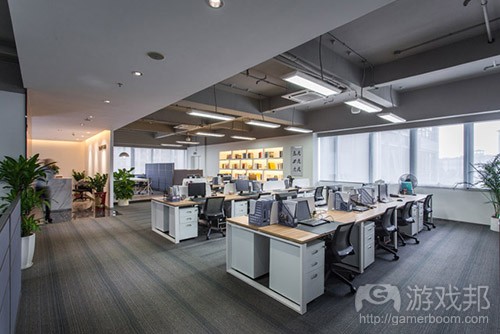如何确保工作室中合作与分心的平衡
作者:Kevin Morris
我总是非常担心我们团队创意的枯竭,同时我也对极少有开发团队会去完善工作条件感到惊讶。像DeMarco和Lister’s Coding Wars等工作室都向我们证实了工作场所对于团队生产力的重要性。他们发现待在一个安静,私人且不被打扰的工作环境中的软件开发者总是能够创造出更棒且较少缺点的结果。他们也认为开放式办公室是最不能发挥生产力的工作环境。但即使如此,我也听说过两个为开放式办公室辩护的理由,即合作和成本效率。
我非常理解开放式办公室的魅力。如果Joe今天需要与Bob一起工作去完成一个任务,他只需要转动办公椅到Bob的位置上便可以开始工作了。但不幸的是其余的团队成员不得不围绕着他们即兴的合作去工作。人类总是有能力能够屏蔽或过滤一些静态的周边信息并提炼出真正重要的内容。这种能力让我们可以不用去考虑摩擦皮肤的衣装或无时无刻充斥在耳边的别人的交流声。
但是我们却并不擅长屏蔽创意信息。所以当Joe和Bob决定审查最新的猫视频时,任何位于听力范围内的员工便会立刻受到影响。根据我在一间开放式办公室中的经验,当其他同事正在进行即兴的讨论会时,我的视线总是会被他们所吸引。虽然这听起来好像蛮有趣的,但是如果所有人都只是盯着讨论中的人,那么他们便不能专注于眼前的工作了。我认为开放式办公室所引起的分心远超过轻松合作所创造的利益。流状态的原则在于它将花费15分钟的时间专注于某些内容并最终进入某一区域。任何可能打断流状态的事物都会迫使你再次启动计时器,并最终导致你未能赶上截止日期。就像你把工作带回家便会遇到这样的情况。
支持开放式办公室的另一个理由是成本。简单来说,开放式办公室的装修比到处竖着墙壁更便宜。但是否真的如此?让我们仔细来看看。我们都知道,时间==金钱。即如果一个人在特定时间内能够创造出更多产品,他便能够创造更多钱。在游戏中,如果我能在截止日期前创造出更多功能,游戏成功的可能性便更大。
所以如果时间等同于我们想要创造的商品,那么我们为什么要因为一些不必要的干扰内容而浪费时间呢?每当一个开发团队成员脱离流状态时,这都是在消耗开发团队的钱。而如果我们能够放弃开放式办公室并提供给团队成员完成工作所需要的安静环境,这便能够剩下不少的经费。
虽然这么说,我还是非常支持成员合作的。这是创造性过程的必要部分。最理想的情况是,我们在一个包含所有对完成任务有必要的元素的中立环境中进行合作。为了追求最佳性能,开发团队必须努力做到合作与分心间的平衡。我并不能说一个绝对安静的工作环境适合所有人。但是我却会建议你们使用一个专门的合作区域或“休息室”去创造一个真正有利于工作的环境。
(本文为游戏邦/gamerboom.com编译,拒绝任何不保留版权的转发,如需转载请联系:游戏邦)
The Fine Line between Collaboration and Distraction
by Kevin Morris
With all the fuss over milking every last ounce of creativity out of a team, I am surprised how very few development teams focus on maximizing working conditions. Studies, like DeMarco and Lister’s Coding Wars, demonstrates the importance workplace has on team productivity. They found that software developers working in environments reported to be acceptably quiet, private, and free of unnecessary interruption produced better results and with less defects. They specifically identified open floor plans (you know, the ones game studios often use) to be one of the worst environments for productivity. Despite this, I’ve heard open floor plans defended mainly for two reasons, collaboration and cost efficiency.
I completely understand the appeal of open configurable floor plans. If Joe needs to work with Bob today to get a task done, he just wheels his desk up and starts working. Unfortunately, the rest of the team is privy to their impromptu collaboration. Humans have the uncanny ability to tune out and filter static peripheral information and hone in on what is important. This allows us to not think about the clothes touching our skin or the sound of the AC every second of the day.
What we don’t do well is tune out novel information. So when Joe and Bob decide to check out the latest cat video, anyone in earshot is immediately distracted. From my experience working in an open floor plan, I have looked around the room more than once after having an urgent impromptu meeting to find all eyes on me. As flattering as that may sound, if everyone is looking at me then they are not looking at the work in front of them. I believe the distraction caused by an open floor plan outweighs the benefits of easy collaboration. The principle of flow states it takes around 15 minutes of uninterrupted concentration to get into the zone. Any disruption of flow starts the timer all over again, and we wonder why we’re missing deadlines. If you’re taking work home with you, this could be why.
The second reasoning behind open floor plans is cost. Plain and simple, open floor plans are cheaper than walls. But are they really? Let’s examine this for a moment. If the classic equation is true, then Time = Money. The more product a person can produce in the allotted time the more money generated. In the context of games, the more features I can get done before the deadline the greater the likelihood of the game’s success.
So, if time is a commodity we want to capitalize why would we institute a practice that wastes time by frequent and unnecessary interruption? Every time a member of the development team is snapped out of their flow state, it costs the dev team money. Think of the money saved if we ditched the open floor plans and gave our teams the peace and quiet they need and deserve to do their jobs.
With that said, I’m all for collaboration. It’s absolutely essential to creative processes. Ideally, however, collaboration happens in a neutral environment that includes only those necessary for the task. In the pursuit of optimal performance, dev teams must clearly strike a balance between collaboration and distraction. I don’t claim to have an answer as the definition for an acceptably quite working environment differs for every individual. However, I would suggest that using designated collaboration areas or “breakout rooms” would go a long way toward achieving a flow friendly environment.(source:gamasutra)








































 闽公网安备35020302001549号
闽公网安备35020302001549号